3-6. Once again. Possibly the month named Toki was
beginning at the π-day January 29:
|
Jan 29
(394) |
*11 |
Febr 9
(40) |
*3 |
Febr 12
(408) |
13 |
2-14 (45) |
|
*314
→
π |
*325 |
*328 |
*329 |
*330 |
|
ALBALI |
SADALSUD |
NASHIRA |
DENEB
ALGIEDI |
ALL
HEARTS' DAY |
|
Bat |
Rat |
Fortunate
One |
Tail of
the Goat |
|
10 Girl |
11 Emptiness |
26
Western One in the Tail of the Goat |
27
Eastern One in the Tail of the Goat |
War-god
Kuu returned to power |
According to the Arabs this place - where the Sun
reached the star ε
Aquarii (Al-bali) - was named the
Good Fortune of the Swallower.
... In the morning of the world, there
was nothing but water. The Loon was calling, and the old man
who at that time bore the Raven's name, Nangkilstlas,
asked her why. 'The gods are homeless', the Loon replied.
'I'll see to it', said the old man, without moving from the
fire in his house on the floor of the sea. Then as the old
man continued to lie by his fire, the Raven flew over the
sea. The clouds broke. He flew upward, drove his beak into
the sky and scrambled over the rim to the upper world. There
he discovered a town, and in one of the houses a woman had
just given birth. The Raven stole the skin and form of the
newborn child. Then he began to cry for solid food, but he
was offered only mother's milk That
night, he passed through the town stealing an eye from each
inhabitant. Back in his foster parents' house, he roasted
the eyes in the coals and ate them, laughing. Then he
returned to his cradle, full and warm. He had not seen the
old woman watching him from the corner - the one who never
slept and who never moved because she was stone from the
waist down. Next morning, amid the wailing that engulfed the
town, she told what she had seen. The one-eyed people of the
sky dressed in their dancing clothes, paddled the child out
to mid-heaven in their canoe and pitched him over the side
...
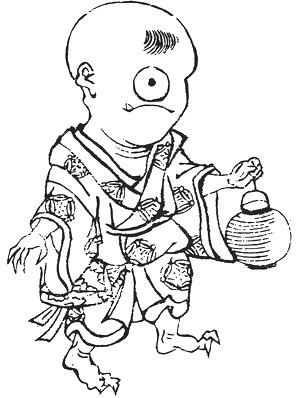
|
Al Sa’d al Bula'-21 (Good Fortune of the
Swallower)
/
Dhanishta-24 (Most Famous)
/
Girl-10 (Bat)
YUE
(Battle-Axe) = ψ
Capricorni
(314.3),
GIENAH CYGNI =
ε
Cygni,
η
Cephei (314.5),
γ
Delphini (314.6),
σ
Pavonis (314.7),
ALBALI =
ε
Aquarii
(314.8)
BETELGEUZE (α
Orionis) |
BATEN ALGIEDI (Belly of the Goat) =
ω
Capricorni
(315.8) |
μ
Aquarii (316.0) |
ε
Equulei (317.8) |
No
star listed (318) |
21h (319.6)
ARMUS =
η
Capricorni
(319.0),
DORSUM =
θ
Capricorni
(319.3),
TSOO = 24 Capricorni
(319.7) |
DRAMASA =
σ
Oct.,
χ
Capricorni (320.0),
ν
Aquarii (320.3),
γ
Equulei (320.6),
ο
Pavonis (320.8) |
 |
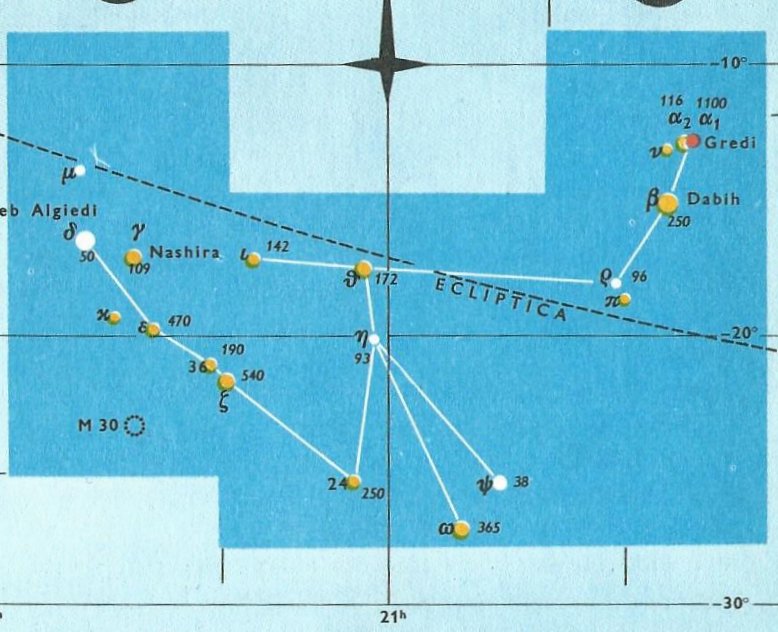 |
| Jan
29 |
30 |
31
(396) |
Febr 1 (32) |
2 |
3 |
4 (400) |
|
... The Sacred Book of the ancient
Maya Quiche, the famous Popol Vuh (the Book of Counsel) tells of
Zipacna, son of Vucub-Caquix (= Seven Arata). He sees 400 youths
dragging a huge log that they want as a ridgepole for their house.
Zipacna alone carries the tree without effort to the spot where a hole
has been dug for the post to support the ridgepole. The youths, jealous
and afraid, try to kill Zipacna by crushing him in the hole, but he
escapes and brings down the house on their heads. They are removed to
the sky, in a 'group', and the Pleiades are called after them ... |
 |
 |
 |
 |
 |
 |
 |
|
Ea3-12
(77) |
Ea3-13 |
Ea3-14 →
π |
Ea3-15
(80) |
Ea3-16 |
Ea3-17 |
Ea3-18 |
| tagata mau toki |
ko te vae |
toki |
henua |
toki |
kiore - hokohuki |
kiore tupu |
|
... In China, with Capricornus,
Pisces, and a part of Sagittarius, it [Aquarius] constituted the early
Serpent, or Turtle, Tien Yuen; and later was known as Hiuen
Ying, the Dark Warrior and Hero, or Darkly Flourishing One, the
Hiuen Wu, or Hiuen Heaou, of the Han dynasty,
which Dupuis gave as Hiven Mao. It was a symbol of the emperor
Tchoun Hin, in whose reign was a great deluge; but after the Jesuits
came in it became Paou Ping, the Precious Vase. It contained
three of the sieu, and headed the list of zodiac signs as the Rat,
which in the far East was the ideograph for 'water', and still so
remains in the almanacs of Central Asia, Cochin China, and Japan
...

Tupu. 1.
Shoot, sprout, bud; to sprout, to bud. 2. Pregnant: vî'e tupu (o te
poki); to be conceived (of fetus in its mother's womb): he-tupu
te poki i roto i te kopú o toona matu'a. Vanaga. To grow, to sprout,
to germinate, to come forth, to conceive, pregnant, germ; mea tupu,
plant; tupu ke avai, of rapid growth; tupu horahorau,
precocious; hakatupu, to produce, to stimulate growth, to excite.
P Pau.: fakatupu, to raise up, to create. Mgv.: tupu, to
grow, to conceive, to be pregnant. Mq.: tupu, to grow, to sprout,
to conceive. Ta.: tupu, to grow, to sprout. Churchill. Mgv.:
Tupu, the best or worst, used of men or of bad qualities. Sa.:
tupu, king. Ma.: tupu, social position, dignity. Churchill.
... Another year passed, and a man by the name of
Ure Honu went to work in his banana plantation. He went and came to
the last part, to the 'head' (i.e., the upper part of the banana
plantation), to the end of the banana plantation. The sun was standing
just right for Ure Honu to clean out the weeds from the banana
plantation. On the first day he hoed the weeds. That went on all day,
and then evening came. Suddenly a rat came from the middle of the banana
plantation. Ure Honu saw it and ran after it. But it disappeared
and he could not catch it. On the second day
of hoeing, the same thing happened with the rat. It ran away, and he
could not catch it. On the third day, he reached the 'head' of the
bananas and finished the work in the plantation. Again the rat ran away,
and Ure Honu followed it. It ran and slipped into the hole of a
stone. He poked after it, lifted up the stone, and saw that the skull
was (in the hole) of the stone. (The rat was) a spirit of the skull (he
kuhane o te puoko). Ure Honu was amazed and said, 'How
beautiful you are! In the head of the new bananas is a skull, painted
with yellow root and with a strip of barkcloth around it.' Ure Honu
stayed for a while, (then) he went away and covered the roof of his
house in Vai Matā. It was a new house. He took the very large
skull, which he had found at the head of the banana plantation, and hung
it up in the new house. He tied it up in the framework of the roof (hahanga)
and left it hanging there ... |
|
γ
Pyxidis (133.6) |
ζ
Hydrae (134.1),
ρ
Cancri (134.2),
ζ
Oct.
(134.3), ο Cancri (134.6), δ Pyxidis (134.9) |
ACUBENS
= α Cancri,
TALITHA BOREALIS = ι Ursae Majoris
(135.0),
σ Cancri (135.2), ρ Ursa Majoris (135.6) |
ν Cancri
(136.0),
TALITHA
AUSTRALIS = κ Ursae Majoris
(136.1),
ω Hydrae (136.8) |
9h (137.0)
σ¹ Ursa Majoris (137.0), κ Cancri (137.3),
τ Cancri (137.4),
ALSUHAIL (al Wazn, of the
Weight) = λ Velorum
(137.5), σ² Ursa Majoris (137.6), τ Ursa Majoris (137.7), ξ Cancri
(137.8)
*96.0 = *137.4 - *41.4 |
κ
Pyxidis (138.0), ε Pyxidis (138.5) |
π
Cancri (139.2),
MIAPLACIDUS =
β
Carinae
(139.3),
TUREIS (Little Shield) =
ι
Carinae
(139.8) |
 |
|
July 31 (212) |
Aug
1 |
2
(314 - 100) |
3
(580 = 397 + 183) |
4 (2 * 108) |
5 |
6
(139 + 79) |
|
... It was 4 August 1968, and it was
the feast day of Saint Dominic, patron of Santo Domingo Pueblo,
southwest of Santa Fe. At one end of the hot, dusty plaza, a Dominican
priest watched nervously as several hundred dancers arranged in two long
rows pounded the earth with their moccasined feet as a mighty,
collective prayer [ui] for rain, accompanied by the powerful
baritone singing of a chorus and the beat of drums. As my family and I
viewed this, the largest and in some ways the most impressive Native
American public ceremony, a tiny cloud over the Jémez Mountains to the
northwest got larger and larger, eventually filling up the sky; at last
the storm broke, and the sky was crisscrossed by lightning and the
pueblo resounded with peals of rolling thunder ... |
At the opposite side of the year, compared to January 29
(394), was the last day in July (394 - 182 = 212).
Or *314 (January 29) -
*132 (July 31) = *182 → 2 * 91 → 26 weeks
→ 13 * 14 days → 364.0 / 115.88.
Thus in a way August 1 corresponded to February 1. This
correspondence becomes quite clear when we consider the
proper length of the astronomical year to be 364 days.
... Another name for Mercury was Hermes
and Hermes Trismegisthos (thrice-mighty) could have
referred to the fact that there were 3.141 *
115.88 = 364.0
days for the cycle of the Earth around the Sun. Although the
calendar has 365 days for a year this is due to the fact
that the Earth has to turn around an extra day in order to
compensate for how the direction to the Sun changes during a
year ...

|
321.5), δ
Equulei (321.7),
φ
Capricorni (321.8) |
KITALPHA (Part of a Horse) =
α
Equulei
(322.0),
ALDERAMIN (The Right Arm) =
α
Cephei
(322.9) |
DAI =
ι
Capricorni
(323.5),
β
Equulei (323.8) |
γ
Pavonis (324.1),
YAN =
ζ
Capricorni
(324.6) |
Al Sa'd al Su'ud-22 (Luckiest of the Lucky)
/
Emptiness-11 (Rat)
TSIN = 36 Capricorni
(325.2),
ALPHIRK (The Flock) =
β
Cephei
(325.7),
SADALSUD =
β
Aquarii,
ξ
Gruis (325.9)
|
No star listed (326) |
CASTRA =
ε
Capricorni
(327.2),
BUNDA (Foundation) =
ξ
Aquarii
(327.5)
SIRIUS (α Canis Majoris) |
Mahar sha hi-na Shahū-26
(Western One in the Tail of the Goat)
NASHIRA (Fortunate One) =
γ
Capricorni
(328.0),
ν
Oct. (328.3),
AZELFAFAGE (Horse's Foot Track) =
π¹
Cygni,
κ
Capricorni (328.7) |
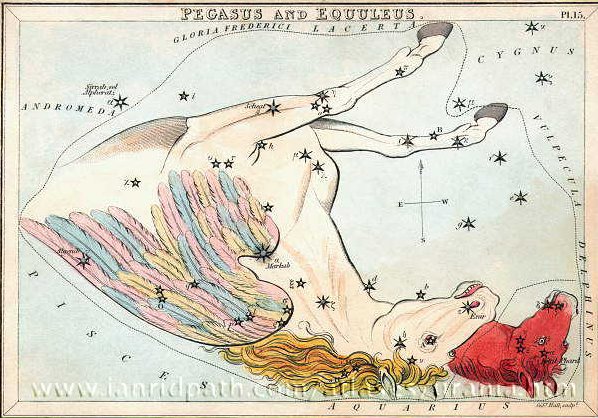 |
|
Febr 5 (36) |
6 |
7 |
8 (404) |
9 (40) |
10 |
11 |
12 (408) |
|
... On February 9 the Chorti Ah K'in,
'diviners', begin the agricultural year. Both the
260-day cycle and the solar year are used in setting
dates for religious and agricultural ceremonies,
especially when those rituals fall at the same time
in both calendars. The ceremony begins when the
diviners go to a sacred spring where they choose
five stones with the proper shape and color. These
stones will mark the five positions of the sacred
cosmogram created by the ritual. When the stones are
brought back to the ceremonial house, two diviners
start the ritual by placing the stones on a table in
a careful pattern that reproduces the schematic of
the universe. At the same time, helpers under the
table replace last year's diagram with the new one.
They believe that by placing the cosmic diagram
under the base of God at the center of the world
they demonstrate that God dominates the universe.
The priests place the stones in a very particular
order. First the stone that corresponds to the sun
in the eastern, sunrise position of summer solstice
is set down; then the stone corresponding to the
western, sunset position of the same solstice. This
is followed by stones representing the western,
sunset position of the winter solstice, then its
eastern, sunrise position. Together these four
stones form a square. They sit at the four corners
of the square just as we saw in the Creation story
from the Classic period and in the Popol Vuh.
Finally, the center stone is placed to form the
ancient five-point sign
modern researchers called the quincunx ...
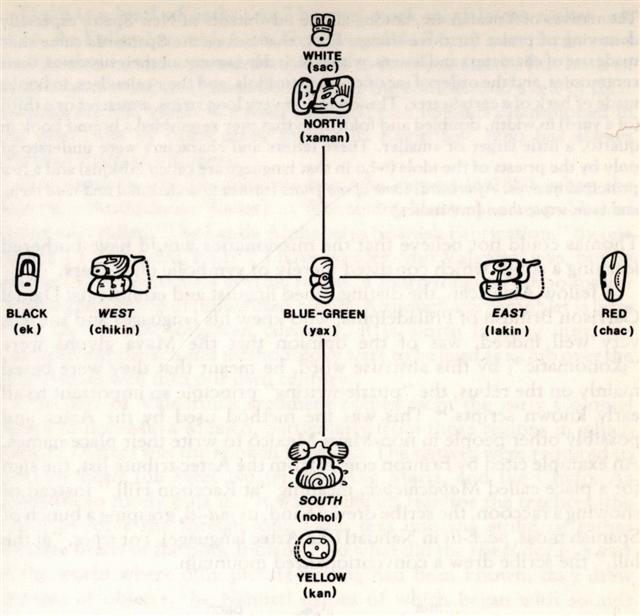
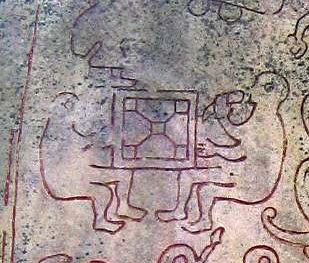 |
 |
 |
 |
 |
 |
 |
 |
 |
|
Ea3-19
(84) |
Ea3-20 |
Ea3-21 |
Ea3-22 |
Ea3-23 (88) |
Ea3-24 |
Ea3-25 |
Ea3-26 |
| tagata
rere toki |
manu puo
pouo |
toki |
mauga |
toki i te henua ku tutu raua |
marama |
marama |
|
Tutu, 1. Circle of fishing nets arranged
in the shape of a funnels or baskets. 2. To light a
fire; he-tutu i te ahi: to burn something. 3.
To hit, to strike, to beat. Tûtú, to shake
(something) clean of dust or dirt; he-tûtú te
oone o te nua, to shake the dirt off a nua
cape. Tutuhi, to reject the responsibility
for a mistake onto one another, to blame one another
for a mistake (see tuhi). Tutuki, to
stumble, to trip. O tutuki te va'e, in order
not to trip. Tutuma, firebrand, partly burnt
stick. Tuturi, to kneel. Vanaga. 1. To beat
bark for cloth. PS Pau., Mgv., Mq., Ta.: tutu,
id. Sa., To., Fu.: tutu, id. 2. A broom, to
sweep, to clean. Mq.: tutu, to beat out the
dust. 3. To shake, to winnow. Mgv.: tutu, to
tremble, to leap. Mq.: tutu, to shake. 4. To
kindle, to light, to ignite, to set fire, to burn.
Mq.: tutu, to burn, to set fire. 5. To stand;
hakatutu, to set joists. P Mgv., Mq.: tutu,
to stand upright. Ta.: tu, id. Tutua (tutu
1): board on which bark is beaten into cloth. PS
Mgv.: tutua, a cloth beater. Mq., Ta.:
tutua, wood on which cloth is beaten. Sa., Fu.:
tutua, id. Tutui: tutui ohio,
chain, tutui kura, shawl. Mq.: tuitui kioé,
chain. Tutuki: shock, contusion, to run
against, to collide; tukukia, to run foul of.
P Pau.: tukituki, to strike, to pound, to
grind. Mgv.: tukia, to strike against, shock,
concussion. Mq.: tutuki, id. Ta.: tui,
id. Tutuma: 1. (tutu - ma) a
live coal. 2. Tree trunk T (? tumu).
Tutumata, ligament of the eye, orbit, eyelid. T
(tutumate, eyelid G). Tutuu,
bristling. Churchill. |
Day 225 (→ 15 * 15) was by the Mayas considered as
the day when our present world was
created.
August 13 (225, *145) →
*330 (February 14) - *185 (September 22, equinox).
|
Arkat sha hi-na
Shahū-27 (Eastern One in the Tail of the
Goat)
ENIF (The Nose) =
ε
Pegasi, ERAKIS (the Dancer) =
μ
Cephei
(329.2),
46 CAPRICORNI,
JIH (the Sun) =
κ
Pegasi
(329.3),
ι
Piscis Austrini (329.4),
λ
Capricorni (329.6),
ν
Cephei (329.7),
DENEB ALGIEDI =
δ
Capricorni
(329.8)
*288.0 = *329.4 - *41.4 |
θ
Piscis Austrini (330.1),
λ
Oct.
(330.7) |
KUH (Weeping)
=
μ
Capricorni (331.4),
γ
Gruis (331.5)
*290.0 = *331.4 - *41.4 |
|
Febr 13 |
All
Hearts' Day (410) |
15 (46) |
|
Aug 12 |
13 (45 +
180 = 225) |
14 |
 |
 |
 |
|
Ea3-27
(84 + 8) |
Ea3-28 |
Ea3-29
(46 + 48) |
|
tagata - te vai |
hokohuki - kiore -
hokohuki - kiore |
kiore kikiu |
|
... In
the inscriptions of Dendera, published by
Dümichen, the goddess Hathor is
called 'lady of every joy'. For once,
Dümichen adds: Literally ... 'the lady of
every heart circuit'. This is not to say
that the Egyptians had discovered the
circulation of the blood. But the
determinative sign for 'heart' often figures
as the plumb bob at
the end of a plumb line
coming from a well-known astronomical or
surveying device, the merkhet.
Evidently, 'heart' is something very
specific, as it were the 'center of gravity'
... See Aeg.Wb. 2, pp. 55f. for sign of the
heart (ib) as expressing generally
'the middle, the center'. And this may lead
in quite another direction. The Arabs
preserved a name for
Canopus - besides calling
the star Kalb at-tai-man ('heart of
the south') ... Suhail el-wezn,
'Canopus Ponderosus', the heavy-weighing
Canopus, a name promptly declared
meaningless by the experts, but which could
well have belonged to an archaic system in
which Canopus was the weight at the end of
the plumb line, as befitted its important
position as a heavy star at the South Pole
of the 'waters below'. Here is a chain of
inferences which might or might not be
valid, but it is allowable to test it, and
no inference at all would come from the
'lady of every joy'. The line seems to state
that Hathor (= Hat Hor,
'House of Horus') 'rules' the revolution of
a specific celestial body - whether or not
Canopus is alluded to - or, if we can trust
the translation 'every', the revolution of
all celestial bodies. As concerns the
identity of the ruling lady, the greater
possibility speaks for Sirius, but Venus
cannot be excluded; in Mexico, too, Venus is
called 'heart of the earth'. The reader is
invited to imagine for himself what many
thousands of such pseudo-primitive or poetic
interpretations must lead to: a disfigured
interpretation of Egyptian intellectual life
...

... The
Pythagoreans make Phaeton fall into
Eridanus, burning part of its water, and
glowing still at the time when the Argonauts
passed by. Ovid stated that since the fall
the Nile hides its sources. Rigveda 9.73.3
says that the Great Varuna has hidden the
ocean. The Mahabharata tells in its own
style why the 'heavenly Ganga' had to be
brought down. At the end of the Golden Age (Krita
Yuga) a class of Asura who had
fought against the 'gods' hid themselves in
the ocean where the gods could not reach
them, and planned to overthrow the
government. So the gods implored Agastya
(Canopus, alpha Carinae = Eridu) for help.
The great Rishi did as he was bidden, drank
up the water of the ocean, and thus laid
bare the enemies, who were then slain by the
gods. But now, there was no ocean anymore!
Implored by the gods to fill the sea again,
the Holy One replied: 'That water in sooth
hath been digested by me. Some other
expedient, therefore, must be thought of by
you, if ye desire to make endeavour to fill
the ocean ... |
The orbit of the Earth around the Sun was not circular,
instead the northern summer was longer than the southern
summer:
|
Northern summer: |
183 |
 |
180 |
 |
|
α Tauri |
α Scorpii |
|
182 = 13 * 14
days |
|
Southern winter |
... If summer was defined from the equinoxes there
would be 185 days in the northern summer and 180
days in
the southern summer:
|
March |
21 |
80 |
0 |
|
31 |
90 |
10 |
|
April |
30 |
120 |
40 |
|
May |
31 |
151 |
71 |
|
June |
21 |
172 |
92 |
|
30 |
181 |
101 |
|
July |
31 |
212 |
132 |
|
August |
31 |
243 |
163 |
|
September |
22 |
265 |
185 = 145
+ 40 |
|
30 |
273 |
193 |
|
October |
31 |
304 |
224 |
|
November |
30 |
334 |
254 |
|
December |
21 |
355 |
275 |
|
31 |
365 |
285 |
|
January |
31 |
31 |
316 |
|
February |
28 |
59 |
344 |
|
March |
21 |
80 |
365 |
|
31 |
90 |
375 |
|
April |
30 |
120 |
405 = 145
+ 260 |
|
May |
31 |
151 |
436 |
The last day in April is day 120 + 365 = 485 as counted from January 1
in the previous year.
Counted from 0h the distance is 485 (April 30) - 80 (March
21) = 405 = 365 + 40 → *325:
|
Jan 29
(394) |
*11 |
Febr 9
(40) |
*3 |
Febr 12
(408) |
13 |
2-14 (45) |
|
*314
→
π |
*325 |
*328 |
*329 |
*330 |
|
ALBALI |
SADALSUD |
NASHIRA |
DENEB
ALGIEDI |
ALL
HEARTS' DAY |
|
Bat |
Rat |
Fortunate
One |
Tail of
the Goat |
|
10 Girl |
11 Emptiness |
26
Western One in the Tail of the Goat |
27
Eastern One in the Tail of the Goat |
War-god
Kuu returned to power |

|
















